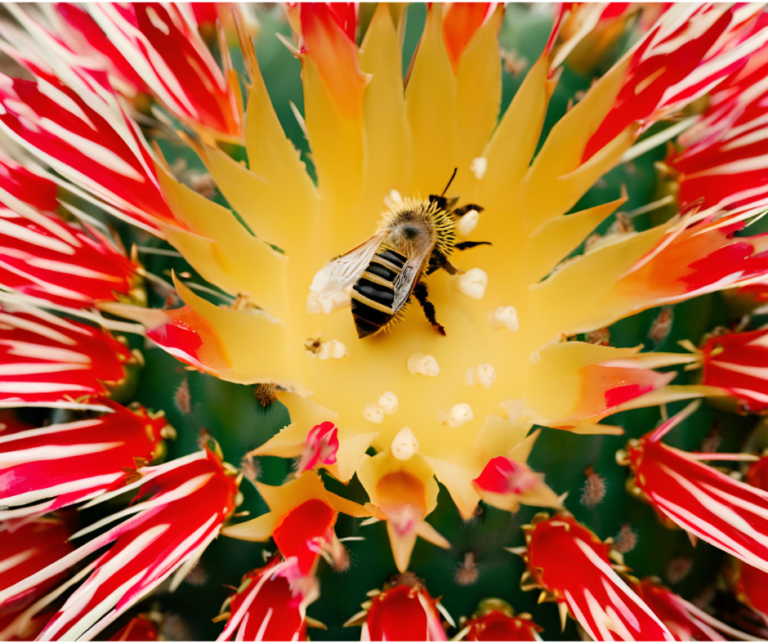In the vast, arid landscapes of the desert, the relationship between the barrel cactus and bee is crucial for sustaining desert ecosystems. The barrel cactus and bee interaction is vital for the pollination of the cactus, while bees rely on the nectar provided by the cactus flowers. This barrel cactus and bee connection not only supports plant reproduction but also plays a key role in the survival of bees in these harsh environments.
What is a Barrel Cactus?
The barrel cactus is a robust desert plant known for its unique cylindrical shape, sharp spines, and colorful blooms. Typically found in deserts across the southwestern United States and Mexico, this cactus can grow up to 10 feet tall and store water within its thick stems. Its flowers, blooming in bright shades of yellow, orange, and red, serve as a crucial food source for bees.
In addition to barrel cacti, many gardeners are also fascinated by other resilient desert plants. Learn more about these desert wonders in this in-depth guide to iconic cactus species.
Bees and Barrel Cactus: A Symbiotic Relationship
Bees and barrel cacti share a mutually beneficial relationship. The cactus flowers produce nectar, which attracts bees. In return, bees help pollinate the cactus, allowing it to reproduce. This exchange is vital for both species, ensuring the survival of the barrel cactus and providing nourishment for honey bees.
For those interested in fostering similar relationships in their own gardens, check out beekeeping in your garden, which offers tips on keeping bees healthy and thriving in your outdoor space.
Pollination Process of Barrel Cactus
The pollination of barrel cactus by bees is a fascinating process. Here’s how it works:
- Flower Attraction: Bright, colorful barrel cactus flowers bloom during the day, attracting bees.
- Nectar Collection: As bees gather nectar, pollen from the cactus flowers sticks to their bodies.
- Cross-Pollination: The bees then carry this pollen to other cacti, aiding in cross-pollination.
- Reproduction: Pollinated flowers develop seeds, which eventually grow into new barrel cacti.
Learn about desert pollination.
Ecological Significance of Barrel Cactus and Bee Interaction
The interaction between barrel cacti and bees plays a vital role in maintaining the balance of desert ecosystems. Not only does this relationship support the reproduction of barrel cacti, but it also helps sustain desert biodiversity by supporting various other species. The flowers provide an essential food source for bees, while the cacti contribute to the overall health of the desert.
This interaction is just one example of how important plants are in desert ecosystems. For more on how plants support their environment, read about growing sunflowers from seed, another plant species that thrives in challenging conditions.
How to Observe Bees Pollinating Barrel Cactus
If you want to observe bees pollinating barrel cacti, the best time to do so is during the flowering season, which typically occurs in the spring and early summer. Here are a few tips for safe observation:
- Best Time: Visit in the morning or early afternoon when both the flowers are open and bees are most active.
- Desert Regions: Popular locations for viewing barrel cacti in bloom include Arizona, California, and Mexico.
- Safety: Always keep a safe distance from both the bees and the cactus’s sharp spines.
Conservation Efforts for Bees and Barrel Cacti
Both bees and barrel cacti face increasing threats from climate change, habitat loss, and human interference. Conservation efforts are vital to protect these species and their habitats. By reducing the use of pesticides and protecting natural habitats, we can ensure that these symbiotic relationships continue to flourish in the desert.
If you’re interested in helping conserve other desert plants and wildlife, consider learning about ways to conserve desert species and ensure their survival for future generations.
FAQs
How often do barrel cacti bloom?
Barrel cacti typically bloom once a year, usually during the spring or early summer, depending on the region.
Are bees the only pollinators of barrel cacti?
While bees are the primary pollinators, other insects and small animals can also contribute to the pollination process.
Can barrel cacti survive without bees?
Without bees, barrel cacti would struggle to reproduce effectively, as they rely heavily on bees for cross-pollination.
What time of year is best for observing barrel cacti in bloom?
The best time to see barrel cacti in bloom is during spring to early summer when the flowers are fully open and bees are actively pollinating them.
Conclusion
The relationship between barrel cacti and bees is a key example of how species can work together to thrive in even the harshest environments. By understanding and appreciating this connection, we can contribute to the conservation of both species and the delicate ecosystems they inhabit.
